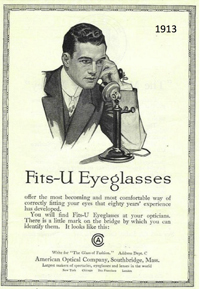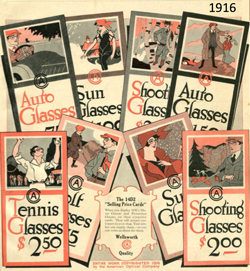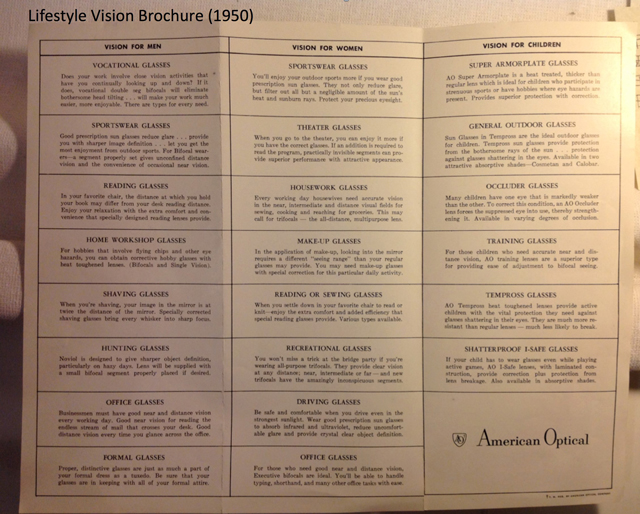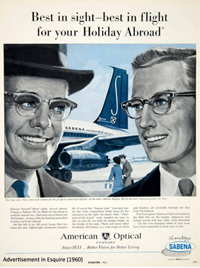
Welcome to Deja View, a new series of VMAIL Weekend articles that looks at eyewear and optical history from a contemporary perspective. Author and optical industry consultant Ted Gioia shares his observations about products and dispensing trends from past decades—some of which were startlingly modern—and illustrates them with vintage ads and displays drawn from the archives of the Optical Heritage Museum in Southbridge, Mass.
What has been the biggest trend in eyewear in recent years? How about the return of tortoise-shell? Or the rise of geeky over-sized specs? Or cat eye glasses to match those feline photos on your Instagram account?
 Images courtesy of Carl Zeiss Vision.
Images courtesy of Carl Zeiss Vision.
Yet lifestyle eyewear is actually more than 100 years old, and its surprising history is now revealed in photos and documents shared online by the Optical Heritage Museum in Southbridge, Massachusetts. These images, many of them unseen for decades, come from the archives of American Optical, now part of Carl Zeiss Vision.
“These innovations from the past laid the groundwork for the high tech eyewear of today,” explained Zeiss vice president Karen Roberts. “Lifestyle needs have changed significantly in the last 100 years. Nowadays, we can offer high performance eyewear optimized for digital devices, driving and other activities. But the basic idea of matching eyewear to specific tasks and lifestyles hasn’t changed.”
 Images courtesy of Carl Zeiss Vision.
Images courtesy of Carl Zeiss Vision.
In 1967 the Chicago Tribune only used the word “lifestyle” seven times during the course of the entire year, but during 1972 it appeared 3,300 times in the pages of that same newspaper. We now take it for granted that eyeglasses are a consumer lifestyle product.
But as far back in 1913, American Optical used the term “Fits-U Eyeglasses” to describe this concept. Over the next decade, the company introduced a range of spectacles to meet the diverse needs of the market. In an era when most people saw eyeglasses as a medical device, American Optical laid the groundwork for its later reinvention as a consumer product.
A hundred years ago, prices for these lifestyle specs ranged from fifty cents for the least expensive pair of auto glasses to $2.50 for fashionable tennis glasses. Those may seem like bargains today but a typical worker only made two or three dollars per day back then.

Images courtesy of Carl Zeiss Vision.
The options for eyewear users expanded with the passing decades. In a 1950 brochure, American Optical was already touting its specialized eyewear for 22 different lifestyles—including theater glasses, hunting glasses, housework glasses and sportswear glasses.
 Images courtesy of Carl Zeiss Vision.
Images courtesy of Carl Zeiss Vision.
“We’ve come a long way since those days,” Roberts said. “Advanced coatings and tints enhance the performance of today’s lifestyle eyewear, and our innovative multifocal designs have made those trifocals obsolete.”
The activities have changed too. “Driving glasses in 1916 were like goggles, and needed to protect wearers from dust and debris in open-air vehicles,” said Optical Heritage Museum executive director Dick Whitney. “But today drivers need more help seeing the complex dashboard controls at mid-vision range as well as traffic and obstacles in the distance.”
So what does the future bring? “High tech lifestyles create new vision needs and also new risks to our eyesight,” Roberts noted. “People may think that eyeglasses are old technology, but they will probably play a key role in how we navigate the lifestyles of the next century.”
Text and images published with permission of Carl Zeiss Vision.